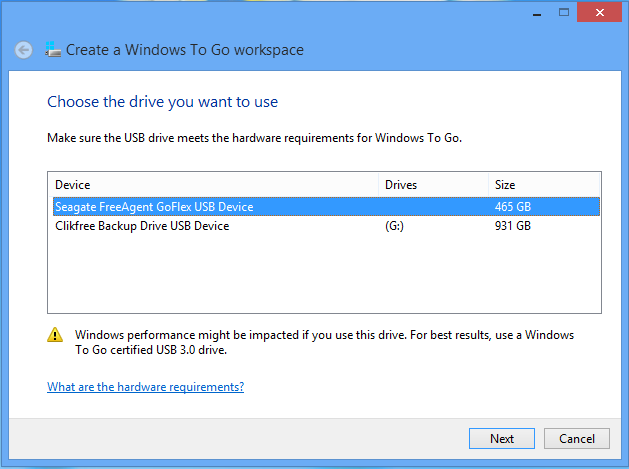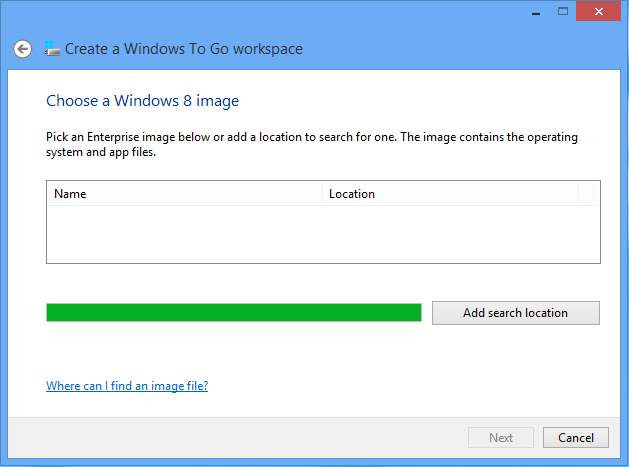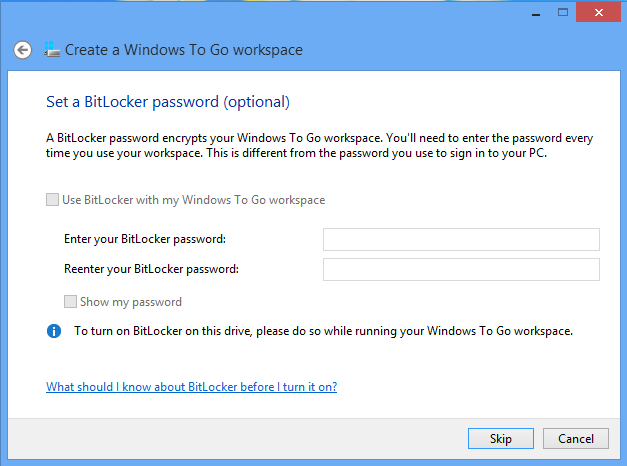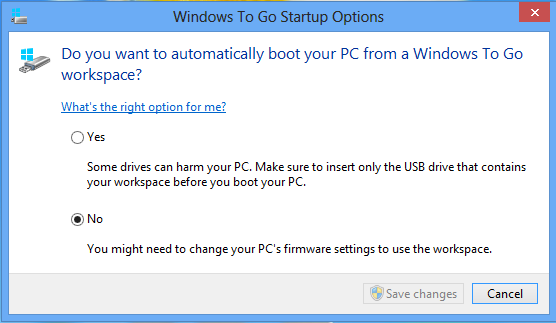Windows To Go Technology in Windows 8
Windows To Go (WTG) technology - one of the new features of Windows 8 - allows you to create a properly configured OS image with the necessary software installed, which will be downloaded directly from USB media, regardless of which OS is installed on the computer to which it is connected USB drive. As part of the post we will briefly discuss possible scenarios for the use of WTG, configuration and some features of use.
A direct result of the use of WTG technology is a bootable USB-drive (flash drive or external HDD), on which Windows 8 is fully ready for use. “Completely ready” means that this OS is properly configured in accordance with the requirements of the organization: it is included in the domain, if necessary, group policies are applied to it, including security policies, patches, remote access technologies (VPN / DirectAccess) are configured, the required set of software is installed, etc. Such media is enough to connect to any computer that is compatible with Windows 7 or Windows 8, and boot directly from it. In this case, you get your personal OS with all the settings and do not affect the OS installed directly on the hard disk of this computer.
Accordingly, WTG refers to the corporate capabilities of Windows 8, that is, it is focused on the use, primarily in the enterprise. The most obvious scenarios for using WTG are:
This list, of course, can be expanded. It is also obvious that all the above scenarios can be implemented in other ways, without WTG. However, the availability of an additional option in the form of WTG can be a good help for the IT department of the organization.
')
First, consider the hardware requirements that exist for both USB-drives and the hosts to which the media will connect.
To support the solution, you need to use media certified for WTG. At the time of writing the post, according to information from the TechNet portal, the list of certified equipment includes:
In practice, I used, for example, a semi-terabyte Seagate FreeAgent GoFlex with USB 3.0, not included in this list. There were no technical problems, but we must remember that firstly, the device must be USB 3.0, and secondly, since the HDD is not certified, then in case of problems you should not contact Microsoft technical support.
Any computer certified for Windows 7 or Windows 8. But again, from a practical point of view, you can talk about any not very outdated x86 or x64 system with USB 2.0 or higher and with the ability to boot from a USB device.
There are three main WTG deployment options:
Whichever deployment option you choose, you will need wim files containing configured OS images and necessary software. Inside the wim file must be Windows 8 Enterprise. Other editions are not supported. In addition, the Windows To Go Creator Wizard is also only available in Windows 8 Enterprise, so this edition is recommended for the machine on which you plan to create WTG.
Assuming that you already have at least one wim file, and the necessary USB drive is connected, let's take a look at the steps to create a WTG using the wizard. Configuration using the command line can be viewed here . You can find the wizard by clicking Win + W and typing “Windows To Go”.
On the first screen, select the desired carrier.

Using the “Add search location” button, specify the folder with the wim file (s).

The wizard analyzes and displays the images found.

On the next screen, you can enable media encryption using BitLocker.

Everything is ready to create a WTG, it remains to click “Create”.

Creating an image takes some time. In my case, the wim-file had a volume of about 3 GB, was located on the SSD-disk, the creation time of the WTG media was 12 minutes.

On the last screen, the wizard suggests changing the boot order of your computer so that the next time the machine boots from USB.

Actually, that's all. It remains to boot from the prepared media and start working.
There are a number of features of WTG that should be kept in mind when operating the technology.
When you first boot from a WTG carrier on some computer, the hardware is detected and the corresponding drivers are installed. This process, of course, takes some time. However, the system remembers the configuration for this computer and subsequent downloads on it occur without delay.
For security reasons, by default, the local hard disk of the computer on which we booted using WTG is offline and access to partitions of this disk is prohibited. This setting can be changed . In addition, if the user has administrative rights to the computer, he can manually transfer the disk to online and gain access to partitions.

For the same reasons, in the opposite situation, when working at a computer, you connect a WTG carrier, Windows mounts this medium without assigning letters to partitions of the medium. Thus, in Windows Explorer, the WTG device is not visible.

When running on a new hardware, Windows should be activated. Let me remind you that WTG is positioned as a corporate opportunity, so it is assumed that the organization has a KMS service or activation via Active Directory (a new feature of Windows Server 2012 ), and then the activation process will go unnoticed for the user.
When using WTG, all Windows features are available, except for the Windows Store. This is done because purchases in the Windows Store are tied to a specific computer, and the corresponding applications are disabled when running on another machine. However, if you need Windows Store to be available, you can enable it for WTG images via group or local policies: \\ Computer Configuration \ Administrative Templates \ Windows Components \ Store \.
The last note is related to setting up the computer boot from USB-drive. If you want the user to independently change the boot order of the computer without getting into the BIOS or pressing any magic key combination, you can use a special utility present in any edition of Windows 8. You can find it in a known way by pressing Win + W and typing “ Windows To Go. ”

Select the desired item, and at the next restart, the system will start booting from USB.

Thus, WTG is a simple and secure way to create a managed Windows 8 mobile image for your employees.
For more information about the Windows To Go technology, please refer to the TechEd Russia 2012 conference “ Review of Windows To Go Technology: New Features, Application Scenarios and Deployment Methods in a Corporate Environment ”.
Active Directory features in Windows Server 2012, including activation via AD, are discussed in the first module of the course “ New Features in Windows Server 2012. Part 2. Security, Management, Remote Access, Web Platform ” in the MVA portal.
Hope the material was helpful.
Thank!
Why do you need it?
A direct result of the use of WTG technology is a bootable USB-drive (flash drive or external HDD), on which Windows 8 is fully ready for use. “Completely ready” means that this OS is properly configured in accordance with the requirements of the organization: it is included in the domain, if necessary, group policies are applied to it, including security policies, patches, remote access technologies (VPN / DirectAccess) are configured, the required set of software is installed, etc. Such media is enough to connect to any computer that is compatible with Windows 7 or Windows 8, and boot directly from it. In this case, you get your personal OS with all the settings and do not affect the OS installed directly on the hard disk of this computer.
Accordingly, WTG refers to the corporate capabilities of Windows 8, that is, it is focused on the use, primarily in the enterprise. The most obvious scenarios for using WTG are:
- Mobile employees . Employees who, for example, often move between company branches and at the same time need each of them to access the corporate network using their settings, documents, etc. Have a small external hard drive or even a flash drive instead of a laptop that weighs a couple of kilograms. For many it can be a very attractive option. Arriving at the next site, it is enough to insert the carrier into a suitable computer.
- Temporary staff working for example in a project. Such an employee may have his own laptop, which does not meet the security requirements of your network. Equip it with a prepared media with the WTG image, and this employee will be able to use your image on his laptop to work on the project.
- Employees without fixed jobs (or working in shifts) who nevertheless need to go to the corporate network in the office or outside it.
- Work from home . If necessary, an employee can download a home computer using a prepared WTG image and access the corporate network and business applications.
This list, of course, can be expanded. It is also obvious that all the above scenarios can be implemented in other ways, without WTG. However, the availability of an additional option in the form of WTG can be a good help for the IT department of the organization.
')
How to configure WTG?
First, consider the hardware requirements that exist for both USB-drives and the hosts to which the media will connect.
Media requirements
To support the solution, you need to use media certified for WTG. At the time of writing the post, according to information from the TechNet portal, the list of certified equipment includes:
- Kingston DataTraveler Workspace for Windows To Go ( http://www.kingston.com/wtg/ )
- Spyrus Portable Workplace ( http://www.spyruswtg.com/ )
- Spyrus Secure Portable Workplace ( http://www.spyruswtg.com/ )
- Super Talent Express RC8 for Windows To Go ( http://www.supertalent.com/wtg/ )
- Western Digital My Passport Enterprise ( http://www.wd.com/wtg )
In practice, I used, for example, a semi-terabyte Seagate FreeAgent GoFlex with USB 3.0, not included in this list. There were no technical problems, but we must remember that firstly, the device must be USB 3.0, and secondly, since the HDD is not certified, then in case of problems you should not contact Microsoft technical support.
Host Requirements
Any computer certified for Windows 7 or Windows 8. But again, from a practical point of view, you can talk about any not very outdated x86 or x64 system with USB 2.0 or higher and with the ability to boot from a USB device.
WTG deployment options
There are three main WTG deployment options:
- using the Windows To Go Creator Wizard;
- using a script (PowerShell + utilities for working with DISM or ImageX images);
- using the User Self-Provisioning tool in System Center 2012 Configuration Manager SP1.
Supported editions of Windows 8
Whichever deployment option you choose, you will need wim files containing configured OS images and necessary software. Inside the wim file must be Windows 8 Enterprise. Other editions are not supported. In addition, the Windows To Go Creator Wizard is also only available in Windows 8 Enterprise, so this edition is recommended for the machine on which you plan to create WTG.
Image creation using Windows To Go Creator Wizard
Assuming that you already have at least one wim file, and the necessary USB drive is connected, let's take a look at the steps to create a WTG using the wizard. Configuration using the command line can be viewed here . You can find the wizard by clicking Win + W and typing “Windows To Go”.
On the first screen, select the desired carrier.

Using the “Add search location” button, specify the folder with the wim file (s).

The wizard analyzes and displays the images found.

On the next screen, you can enable media encryption using BitLocker.

Everything is ready to create a WTG, it remains to click “Create”.

Creating an image takes some time. In my case, the wim-file had a volume of about 3 GB, was located on the SSD-disk, the creation time of the WTG media was 12 minutes.

On the last screen, the wizard suggests changing the boot order of your computer so that the next time the machine boots from USB.

Actually, that's all. It remains to boot from the prepared media and start working.
Features of using WTG
There are a number of features of WTG that should be kept in mind when operating the technology.
When you first boot from a WTG carrier on some computer, the hardware is detected and the corresponding drivers are installed. This process, of course, takes some time. However, the system remembers the configuration for this computer and subsequent downloads on it occur without delay.
For security reasons, by default, the local hard disk of the computer on which we booted using WTG is offline and access to partitions of this disk is prohibited. This setting can be changed . In addition, if the user has administrative rights to the computer, he can manually transfer the disk to online and gain access to partitions.

For the same reasons, in the opposite situation, when working at a computer, you connect a WTG carrier, Windows mounts this medium without assigning letters to partitions of the medium. Thus, in Windows Explorer, the WTG device is not visible.

When running on a new hardware, Windows should be activated. Let me remind you that WTG is positioned as a corporate opportunity, so it is assumed that the organization has a KMS service or activation via Active Directory (a new feature of Windows Server 2012 ), and then the activation process will go unnoticed for the user.
When using WTG, all Windows features are available, except for the Windows Store. This is done because purchases in the Windows Store are tied to a specific computer, and the corresponding applications are disabled when running on another machine. However, if you need Windows Store to be available, you can enable it for WTG images via group or local policies: \\ Computer Configuration \ Administrative Templates \ Windows Components \ Store \.
The last note is related to setting up the computer boot from USB-drive. If you want the user to independently change the boot order of the computer without getting into the BIOS or pressing any magic key combination, you can use a special utility present in any edition of Windows 8. You can find it in a known way by pressing Win + W and typing “ Windows To Go. ”

Select the desired item, and at the next restart, the system will start booting from USB.

Thus, WTG is a simple and secure way to create a managed Windows 8 mobile image for your employees.
For more information about the Windows To Go technology, please refer to the TechEd Russia 2012 conference “ Review of Windows To Go Technology: New Features, Application Scenarios and Deployment Methods in a Corporate Environment ”.
Active Directory features in Windows Server 2012, including activation via AD, are discussed in the first module of the course “ New Features in Windows Server 2012. Part 2. Security, Management, Remote Access, Web Platform ” in the MVA portal.
Hope the material was helpful.
Thank!
Source: https://habr.com/ru/post/167377/
All Articles